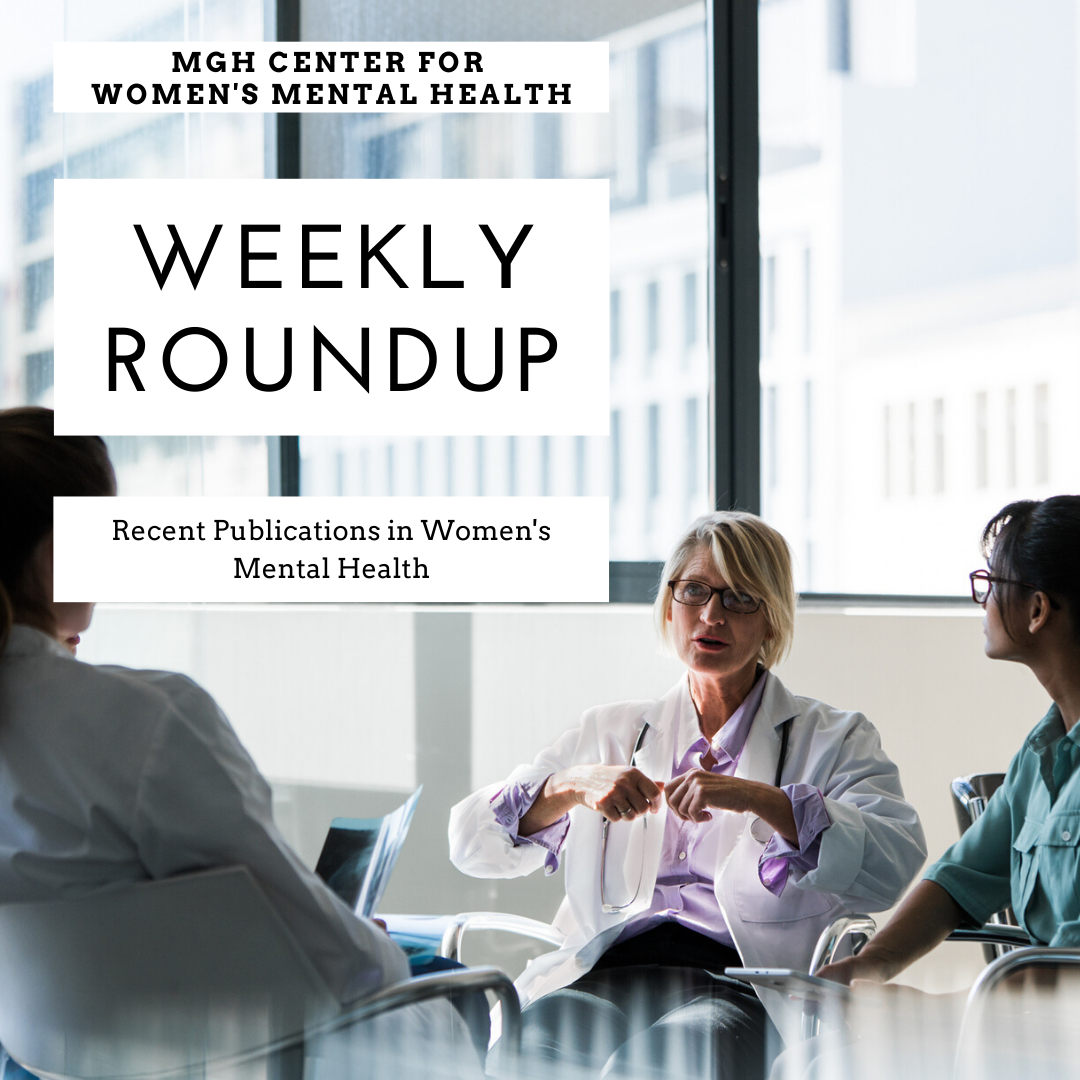
Every week we review the most recent publications in women’s mental health, covering topics related to premenstrual symptoms, perinatal mood and anxiety disorders, use of medications in pregnant and breastfeeding women, perinatal substance use, and menopausal mental health.
For more detailed descriptions of many of these topics, you can sign up to receive our weekly CWMH NEWSLETTER which comes out every Thursday.
Ruta Nonacs, MD PhD
PMS AND PMDD |
| No articles this week |
INFERTILITY AND MENTAL HEALTH |
| No articles this week |
PSYCHIATRIC ILLNESS DURING PREGNANCY |
| The structure of mood and anxiety disorder symptoms in the perinatal period.
Miller ML, O’Hara MW. J Affect Disord. 2023 Mar 15;325:231-239. Pregnant and postpartum women completed a structured clinical interview using the Interview for Mood and Anxiety Symptoms (IMAS). Confirmatory factor analyses identified three latent factors onto which psychiatric symptoms loaded: Distress (depression, generalized anxiety, irritability, and panic symptoms), Fear (social anxiety, agoraphobia, specific phobia, and obsessive-compulsive symptoms), and Bipolar (mania and obsessive-compulsive symptoms) in both pregnancy and the postpartum. Optimization of the Mood Disorder Questionnaire in identification of perinatal bipolar disorder. Millan DM, Clark CT, Sakowicz A, Grobman WA, Miller ES. Am J Obstet Gynecol MFM. 2023 Jan;5(1):100777. The administration of the Mood Disorder Questionnaire in the perinatal period can help to identify which individuals who have screened positive for depression on the Patient Health Questionnaire-9 are at risk of a bipolar or unipolar disorder. Leslie K, Barker LC, Brown HK, Chen S, Dennis CL, Ray JG, Saunders N, Taylor C, Vigod S. CMAJ. 2023 Mar 6;195(9):E322-E329. Overall, 137 (3.1%) of those with schizophrenia had a perinatal ED visit for interpersonal violence, compared with 7598 (0.4%) of those without schizophrenia, for an RR of 6.88 (95% confidence interval [CI] 5.66-8.37) and an adjusted RR of 3.44 (95% CI 2.86-4.15). |
| Psychiatric visits during the postpartum year in women with eating disorders who continue or discontinue antidepressant treatment in pregnancy.
Trinh NTH, Semark BD, Munk-Olsen T, Liu X, Rø Ø, Bulik CM, Torgersen L, Lupattelli A, Petersen LV. Int J Eat Disord. 2023 Mar;56(3):582-594. Women with continued antidepressant treatment both before and during pregnancy did not have a lower probability of having postpartum psychiatric visits for an eating disorder or for mood/anxiety disorders (often coexisting with eating disorders), relative to those who discontinued antidepressants before pregnancy. |
MEDICATIONS AND PREGNANCY |
| Reproductive Safety of Lurasidone and Quetiapine: Update from the National Pregnancy Registry for Psychiatric Medications.
Cohen LS, Church TR, Freeman MP, Gaccione P, Caplin PS, Kobylski LA, Arakelian M, Rossa ET, Chitayat D, Hernández-Díaz S, Viguera AC. J Womens Health (Larchmt). 2023 Jan 30. doi: 10.1089/jwh.2022.0310. A total of 2,293 women were enrolled at the time of analysis; 134 in the lurasidone group, 264 in the quetiapine group, and 886 controls completed the postpartum interview. No specific patterns of malformations were observed in infants exposed to the medications of interest. Lurasidone and quetiapine did not appear to be major teratogens, but further information is needed to refine risk estimates. |
POSTPARTUM PSYCHIATRIC ILLNESS |
| In-person 1-day cognitive behavioral therapy-based workshops for postpartum depression: a randomized controlled trial.
Van Lieshout RJ, Layton H, Savoy CD, Xie F, Brown JSL, Huh K, Bieling PJ, Streiner DL, Ferro MA, Haber-Evans E. Psychol Med. 2023 Mar 7:1-11. Workshops led to meaningful reductions in EPDS scores and were associated with three times higher odds of a clinically significant decrease in PPD [odds ratio (OR) 3.00, 95% confidence interval (CI) 1.93-4.67]. Anxiety also decreased and participants had three times the odds of clinically significant improvement (OR 3.20, 95% CI 2.03-5.04). |
| Association of Antenatal COVID-19-Related Stress With Postpartum Maternal Mental Health and Negative Affectivity in Infants.
Schweizer S, Andrews JL, Grunewald K, Kumle L; COVID-19 Risks Across the Lifespan (CORAL) Consortium. JAMA Netw Open. 2023 Mar 1;6(3):e232969. The findings of this cohort study suggest that targeting pandemic-related stressors in the antenatal period may improve maternal and infant outcomes. Pregnant individuals should be classified as a vulnerable group during pandemics and should be considered a public health priority, not only in terms of physical health but also mental health. |
| Postpartum Psychosis during Delivery Hospitalizations and Postpartum Readmissions, 2016-2019.
Albers SM, Wen T, Monk C, Logue TC, D’Alton ME, Booker WA, Friedman AM. Am J Obstet Gynecol MFM. 2023 Feb 10:100905. Of 12,334,506 deliveries in the analysis 13,894 (1.1 per 1000) carried a diagnosis of postpartum psychosis during the hospitalization for childbirth/delivery and 7,128 (0.6 per 1000) had a 60-day postpartum readmission for postpartum psychosis. Clinical factors with the highest adjusted odds for postpartum psychosis readmission included delivery postpartum psychosis (aOR 5.8, 95% CI 4.2, 8.0), depression disorder (aOR 3.7, 95% CI 3.3, 4.2), bipolar spectrum disorder (OR 2.9, 95% CI 2.3, 3.5), and schizophrenia spectrum disorder (aOR 2.9, 95% CI 2.1, 4.0). The Role of Lamotrigine in Postpartum Psychosis. Chen AS, Kendall LK. Prim Care Companion CNS Disord. 2022 Jul 28; 24(4):21cr03187. Case report: While bipolar disorder is the most common underlying primary psychiatric disorder associated with postpartum psychosis, it is important to differentiate between bipolar disorder versus an isolated postpartum psychosis, as it may affect the approach to treatment. Felder JN, Roubinov D, Zhang L, Gray M, Beck A. Arch Womens Ment Health. 2023 Feb;26(1):67-74. Prenatal sleep disturbance was associated with higher odds of postpartum depressive symptoms (aORs 1.9, 95% CI 1.2-3.1 for first trimester; 3.7, 95% CI 1.5-11.5 for second trimester; 3.4, 95% CI 1.9-6.8 for third trimester). Effect of Zuranolone on Concurrent Anxiety and Insomnia Symptoms in Women With Postpartum Depression. Deligiannidis KM, Citrome L, Huang MY, Acaster S, Fridman M, Bonthapally V, Lasser R, Kanes SJ. J Clin Psychiatry. 2023 Jan 30;84(1):22m14475. Rates of concurrent remission of depressive and anxiety symptoms were higher with zuranolone versus placebo (P < .05) at days 3, 15, and 45; the rate of sustained concurrent remission (ie, at both days 15 and 45) was also higher with zuranolone (P < .05). Social Media-based Parenting Program for Women With Postpartum Depressive Symptoms: An RCT. Guevara JP, Morales K, Mandell D, Mogul M, Charidah T, Luethke M, Min J, Clark R, Betancourt L, Boyd R. Pediatrics. 2023 Mar 1;151(3):e2022058719. A social media-based parenting program led to more rapid declines in depressive symptoms but no differences in responsive parenting, parenting stress, or parenting competence relative to a comparison group. Social media can provide parenting support for women with postpartum depressive symptoms, but greater attention to engagement and treatment access are needed to improve parenting outcomes. |
| Identification of Postpartum Depression in Electronic Health Records: Validation in a Large Integrated Health Care System.
Slezak J, Sacks D, Chiu V, Avila C, Khadka N, Chen JC, Wu J, Getahun D. JMIR Med Inform. 2023 Mar 1;11:e43005. PPD is not reliably captured in the clinical diagnosis coding of EHRs. The accuracy of PPD identification can be improved by supplementing clinical diagnosis with pharmacy use records. |
MEDICATIONS AND BREASTFEEDING |
| No articles this week |
PERINATAL SUBSTANCE USE |
| No articles this week |
MATERNAL MENTAL HEALTH AND CHILD OUTCOMES |
| Association of Interparental Violence and Maternal Depression With Depression Among Adolescents at the Population and Individual Level.
Gondek D, Howe LD, Gilbert R, Feder G, Howarth E, Deighton J, Lacey RE JAMA Netw Open. 2023 Mar 1;6(3):e231175. In this cohort study, parental IPV and maternal depression were associated with depression in adolescence at the population level. However, estimation of an individual developing depression in adolescence based only on information about IPV or maternal depression is poor. Preventive Health Care Among Children of Women With Schizophrenia: A Population-Based Cohort Study. Taylor CL, Brown HK, Saunders NR, Barker LC, Chen S, Cohen E, Dennis CL, Ray JG, Vigod SN. J Clin Psychiatry. 2023 Mar 1;84(2):22m14497. About 50.3% of children with maternal schizophrenia had an enhanced 18-month well-baby visit versus 58.6% of those without. Full vaccine schedule adherence occurred in 40.0% of children with maternal schizophrenia versus 46.0% of those without. The association was lessened after adjusting for maternal sociodemographics and child and maternal health characteristics. |
MENOPAUSE AND MENTAL HEALTH |
| No articles this week |
OTHER TOPICS IN WOMEN’S MENTAL HEALTH |
| No articles this week |



Leave A Comment